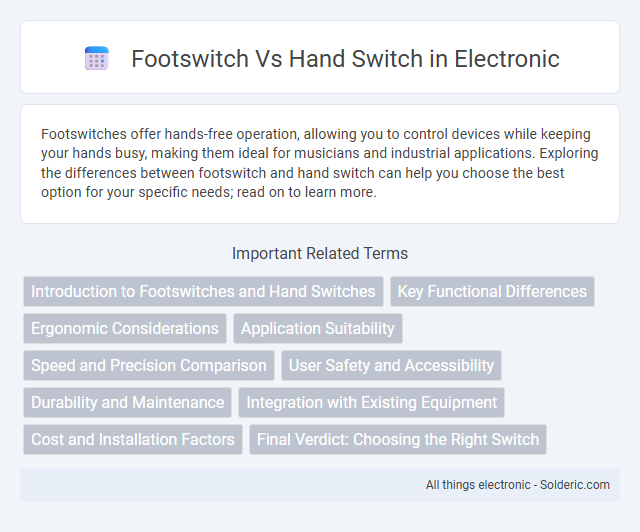Footswitches offer hands-free operation, allowing you to control devices while keeping your hands busy, making them ideal for musicians and industrial applications. Exploring the differences between footswitch and hand switch can help you choose the best option for your specific needs; read on to learn more.
Comparison Table
| Feature | Footswitch | Hand Switch |
|---|---|---|
| Operation Method | Activated by foot pressure | Activated by hand manipulation |
| Use Case | Hands-free control, commonly in musical instruments and industrial equipment | Manual control, used in appliances, machinery, and handheld devices |
| Ergonomics | Allows multitasking, reduces hand fatigue | Simple direct control, may cause hand fatigue over extended use |
| Precision | Moderate precision, depends on foot control | High precision, direct hand input |
| Installation | Requires floor space and stable base | Compact, easy to install on devices |
| Typical Applications | Guitar effects pedals, sewing machines, medical devices | Light switches, power tools, control panels |
Introduction to Footswitches and Hand Switches
Footswitches and hand switches serve as essential control devices in various industrial and medical applications, enabling hands-free and manual operation respectively. Footswitches provide ergonomic advantages by allowing users to keep their hands free for other tasks, enhancing productivity and safety in environments such as surgical procedures and manufacturing lines. Hand switches offer precise control and immediate tactile feedback, making them ideal for applications requiring fine adjustments or rapid response.
Key Functional Differences
Footswitches offer hands-free control, allowing users to operate devices while keeping their hands occupied, ideal for musicians, medical equipment, or industrial machines. Hand switches require manual operation, providing precise and immediate control but limiting multitasking capabilities. Your choice depends on whether you prioritize convenience and safety or direct and tactile input.
Ergonomic Considerations
Footswitches reduce hand fatigue by allowing hands-free operation, making them ideal for tasks requiring continuous manual dexterity. Hand switches offer direct tactile control but can cause strain during prolonged use due to repetitive hand movements. Ergonomically, footswitches promote better posture and reduce upper limb stress, enhancing overall user comfort in extended workflows.
Application Suitability
Footswitches excel in hands-free operation, making them ideal for musicians, surgeons, and industrial workers who require simultaneous hand use. Hand switches offer precise control in situations where the operator's full attention and hand dexterity are essential, such as machinery control panels or electronic devices. Your choice depends on the need for mobility and multitasking efficiency versus fine manual control.
Speed and Precision Comparison
Footswitches offer superior speed and precision by allowing hands-free operation, enabling musicians and professionals to execute commands or changes instantly without diverting manual attention. Hand switches require deliberate hand movement, which can introduce slight delays and reduce efficiency in high-speed or complex tasks. Footswitches improve multitasking capabilities by combining rapid response with consistent accuracy, making them ideal for environments demanding quick, precise input.
User Safety and Accessibility
Footswitches offer enhanced user safety by allowing hands-free operation, reducing the risk of contact with hazardous equipment while maintaining control. Hand switches provide better accessibility in confined spaces or for users needing precise, tactile feedback, minimizing accidental activation through deliberate grip. Your choice between footswitch and hand switch should consider the specific safety requirements and ergonomic accessibility of your work environment.
Durability and Maintenance
Footswitches typically offer greater durability due to their robust construction designed for frequent use and heavy foot pressure, making them ideal for environments requiring consistent performance. Hand switches may require more frequent maintenance because they are more susceptible to wear from repetitive hand movements and environmental factors like moisture or dirt. Your choice between footswitch and hand switch should consider the balance of durability needs and maintenance effort to ensure long-term reliability.
Integration with Existing Equipment
Footswitches often integrate seamlessly with musical instruments and amplifiers, providing hands-free control that enhances performance without disrupting your setup. Hand switches offer more precise manual interaction but may require additional mounting or connection modifications to fit existing equipment. Choosing between them depends on the ease of integration with your current gear and the specific control needs of your setup.
Cost and Installation Factors
Footswitches generally have a higher upfront cost due to specialized hardware and durable materials designed for frequent use, while hand switches tend to be more affordable and widely available. Installation of footswitches often requires modifications to the floor or mounting surfaces, possibly increasing labor and time expenses compared to hand switches, which usually involve simpler wall or panel mounting. Maintenance costs for footswitches can be higher as well because they endure more mechanical stress, whereas hand switches typically feature straightforward replacements with minimal installation disruption.
Final Verdict: Choosing the Right Switch
Choosing between a footswitch and a hand switch depends on your specific needs for convenience and control. Footswitches offer hands-free operation, ideal for multitasking environments, while hand switches provide direct, precise control suited for detailed tasks. Your decision should prioritize ease of use and the type of input method that best enhances your workflow.
footswitch vs hand switch Infographic

 solderic.com
solderic.com